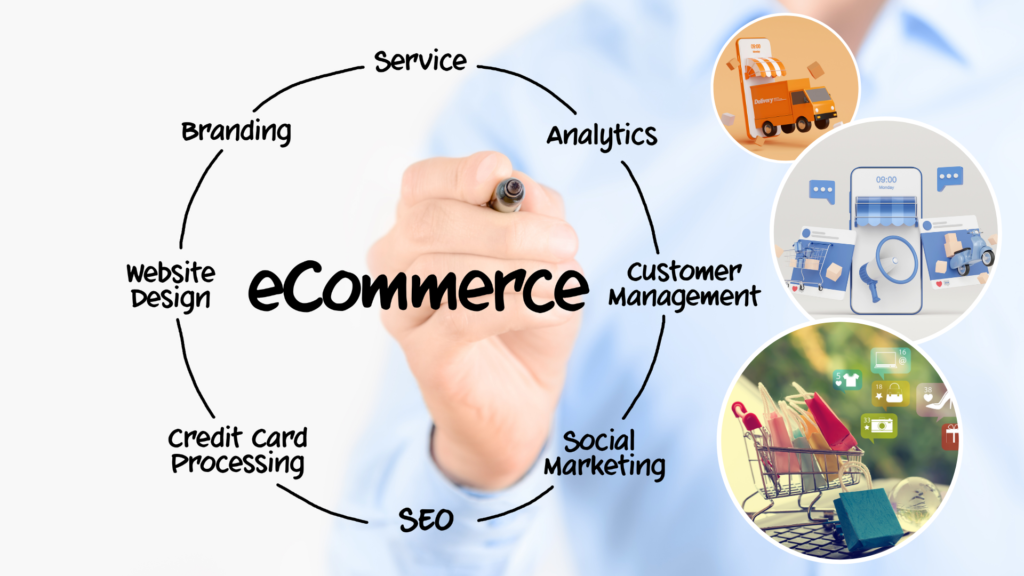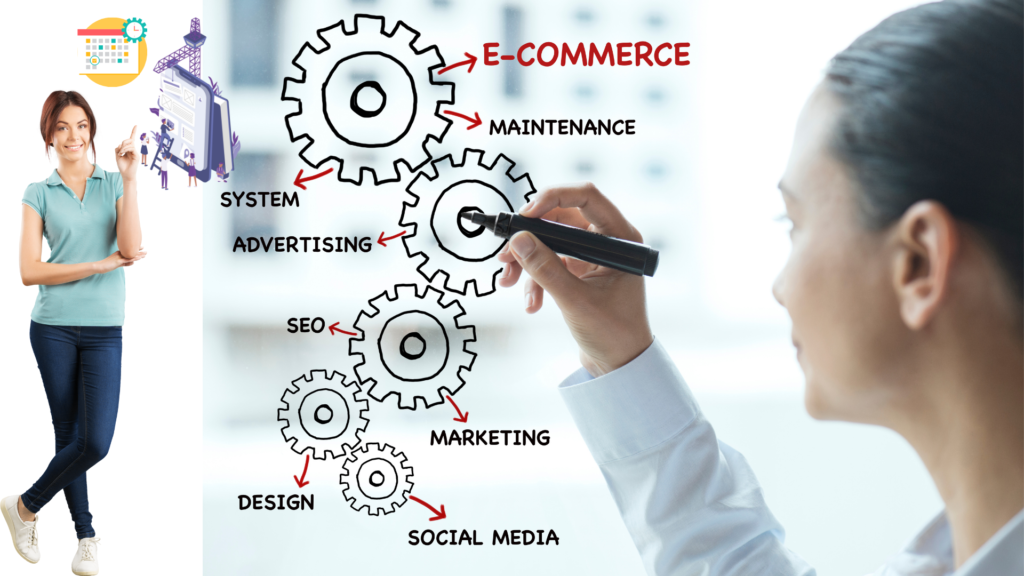
In the digital age, e-commerce has revolutionized the way businesses operate and connect with customers. An effective and user-friendly e-commerce platform is essential for establishing a strong online presence and driving sales. This comprehensive guide explores the world of e-commerce development services, highlighting their significance, impact, future trends, and strategies for success.

1. Understanding E-commerce Development Services
E-commerce development services encompass a wide range of activities dedicated to creating and enhancing online stores. These services involve the design, development, and maintenance of e-commerce websites, ensuring they are visually appealing, functional, and optimized for search engines. Through the use of cutting-edge technologies and industry best practices, e-commerce development experts create platforms that provide seamless user experiences, streamline business operations, and drive sales.

2. Impact of E-commerce Development
The impact of professional ecommerce development services on the success of online businesses cannot be overstated. Let’s explore some key statistics that highlight their significance:
According to Statista, global e-commerce sales reached a staggering $4.28 trillion in 2020, with projections estimating it to surpass $6.38 trillion by 2024.
Mobile commerce, or m-commerce, has experienced significant growth in recent years. In 2021, mobile commerce sales accounted for 54% of total e-commerce sales worldwide (Statista).
User experience plays a crucial role in the success of e-commerce websites. Studies have shown that a well-designed user interface could increase the conversion rate by up to 200% (Forrester).
Search engine optimization (SEO) is instrumental in driving organic traffic to e-commerce websites. The first position on Google search results receives an average click-through rate (CTR) of 34.36% (Infront Webworks).

3. Future of E-commerce Development
The future of e-commerce development is driven by emerging trends and technologies. Here are some key aspects to consider:
Voice commerce: With the rise of virtual assistants like Amazon’s Alexa and Apple’s Siri, voice commerce is gaining momentum. E-commerce development services will need to adapt to this trend by creating voice-activated shopping experiences and optimizing websites for voice search queries.
Augmented Reality (AR) and Virtual Reality (VR): AR and VR technologies offer immersive shopping experiences, allowing customers to visualize products in their own environments or virtually explore stores. E-commerce development services will play a critical role in integrating these technologies into online stores, enhancing the customer experience and driving engagement.
Artificial Intelligence (AI) and Machine Learning (ML): AI and ML technologies are transforming e-commerce in various ways, from personalized product recommendations to chatbots providing instant customer support. E-commerce development services will need to leverage these technologies to create intelligent, data-driven platforms that anticipate customer needs and deliver personalized experiences.
Blockchain technology: Blockchain technology holds the potential for enhancing security, transparency, and trust in e-commerce transactions. E-commerce development services will need to explore the integration of blockchain solutions, enabling secure and decentralized payment systems and improving supply chain management.
Progressive Web Apps (PWAs): PWAs offer the benefits of native mobile apps without the need for app store downloads. Ecommerce development services must embrace PWAs to provide seamless, app-like experiences across devices, enhancing user engagement and increasing conversion rates.

4. Trending Software for E-commerce Development
There are several popular software options for e-commerce development that businesses can consider. Some of the trending ones include:
Shopify: Known for its user-friendly interface and extensive app marketplace, Shopify is a popular choice for e-commerce businesses of all sizes.
WooCommerce: As a customizable and flexible e-commerce plugin for WordPress websites, WooCommerce offers a range of features and integrations.
Magento: With advanced features and scalability, Magento is suitable for larger businesses with complex e-commerce requirements.
BigCommerce: Offering built-in marketing tools and a wide range of integrations, BigCommerce is a scalable platform for growing businesses.
Salesforce Commerce Cloud: Known for its AI-driven personalization and unified commerce capabilities, Salesforce Commerce Cloud caters to enterprise-level businesses.

5. Time Required to Develop an E-commerce Platform
The time required to develop an e-commerce platform depends on various factors such as the complexity of the project, desired features, and the development team’s expertise. On average, it can take anywhere from several weeks to several months. The development process typically includes planning, design, coding, testing, and deployment.

6. Cost of E-commerce Development
The cost of e-commerce development varies depending on factors such as the scope of the project, functionality requirements, and the expertise of the development team. Small-scale e-commerce websites can cost between $5,000 and $20,000, while larger and more complex projects can range from $20,000 to $100,000 or more. Ongoing maintenance and updates should also be considered in the budget.

7. Current Market Challenges for E-commerce Development
The e-commerce development landscape faces various challenges in the current market. Here are some key challenges to be aware of:
Intense competition: The e-commerce market is highly competitive, and businesses need to constantly innovate and differentiate themselves to stand out.
Cybersecurity threats: As online transactions increase, ensuring secure payment processing and customer data protection is crucial to maintain trust and protect against cyber threats.
Mobile optimization: With the increasing usage of mobile devices for online shopping, optimizing e-commerce websites for mobile responsiveness and user experience is essential.
Customer expectations: Meeting customer demands for personalized experiences, fast shipping, easy returns, and seamless transactions is a constant challenge in the dynamic e-commerce landscape.

8. Best Optimization Strategies for E-commerce Platform
To optimize e-commerce websites and drive success, businesses should consider implementing the following strategies:
Search engine optimization (SEO): Implementing SEO best practices, conducting comprehensive keyword research, optimizing page titles, meta tags, and URLs to improve website visibility and increase organic traffic from search engines.
User experience (UX) design: Creating intuitive and user-friendly interfaces, optimizing site navigation, and improving page load speed to enhance the overall user experience and encourage conversions.
Mobile optimization: Ensuring that the e-commerce website is responsive and compatible with different screen sizes and resolutions to cater to the growing number of mobile users.
Personalization: Implementing personalized product recommendations, targeted marketing campaigns, and customized shopping experiences based on customer behavior and preferences to enhance customer engagement and drive conversions.
Streamlined checkout process: Simplifying the checkout process, minimizing cart abandonment rates, and offering multiple payment options to improve the overall customer experience and increase conversions.
Social media marketing: Leveraging social media platforms to promote products, engage with customers, and drive traffic to the e-commerce website.
Customer reviews and ratings: Encouraging customers to leave reviews and ratings, as social proof plays a significant role in building trust and influencing purchase decisions.
Data-driven decision-making: Utilizing advanced analytics and reporting tools to gain insights into customer behavior, website performance, and marketing effectiveness, enabling businesses to make data-driven decisions for continuous improvement.

9. Choosing the Right E-commerce Development Service Provider
Selecting the right e-commerce development service provider is crucial for achieving optimal results. Consider the following factors when evaluating potential providers:
Expertise and experience: Look for service providers with a proven track record in e-commerce development. Assess their portfolio, client testimonials, and case studies to gauge their expertise and experience in creating successful online stores.
Customization and flexibility: Ensure that the service provider can tailor the e-commerce platform to align with your business goals, branding, and unique requirements. A flexible and customizable solution will allow for future scalability and growth.
SEO and marketing capabilities: Verify that the e-commerce development service provider incorporates SEO best practices and implements strategies to enhance online visibility. Effective marketing capabilities can further support your business’s growth and success in the competitive digital landscape.
Ongoing support and maintenance: Check whether the service provider offers post-development support and maintenance services. E-commerce websites require regular updates, security patches, and technical assistance. A reliable support system ensures the smooth operation of your online store.
Conclusion
Investing in professional ecommerce development services is essential for online businesses seeking to thrive in the digital marketplace. The benefits they offer, such as enhanced user experience, mobile optimization, SEO, scalability, and security, play a vital role in driving conversions and revenue growth.
As the e-commerce landscape continues to evolve, staying ahead of emerging trends and adopting innovative technologies will be crucial. By partnering with the right e-commerce development service provider, businesses can ensure that their online stores are equipped with the latest features and functionalities that cater to evolving customer expectations.
Remember, choosing the right e-commerce development service provider and implementing effective optimization strategies are key factors in the success of your online business. Embrace the power of e-commerce development services, leverage emerging trends, and position your business for ongoing growth and profitability in the dynamic world of e-commerce.
Contact Distance Coding https://calendly.com/distancecoding/30min today to discuss your unique needs and discover tailored solutions that align with your goals. We are here to help. Let’s talk and get to know each other. Looking forward to hearing from you.
Distance Coding – www.distancecoding.agency




